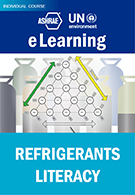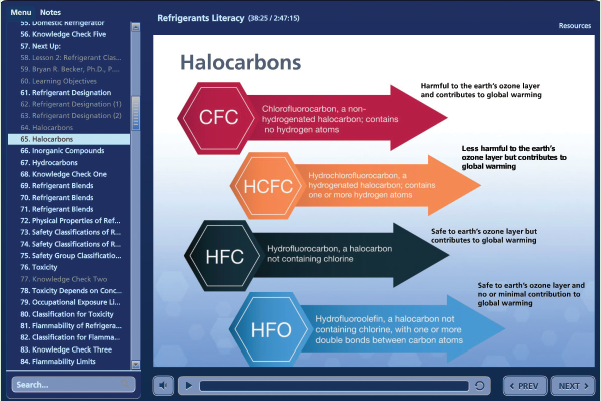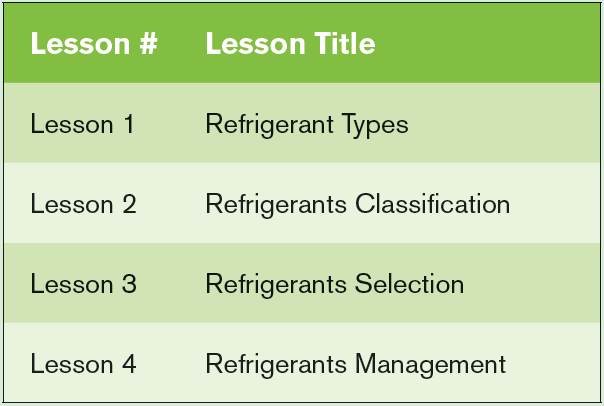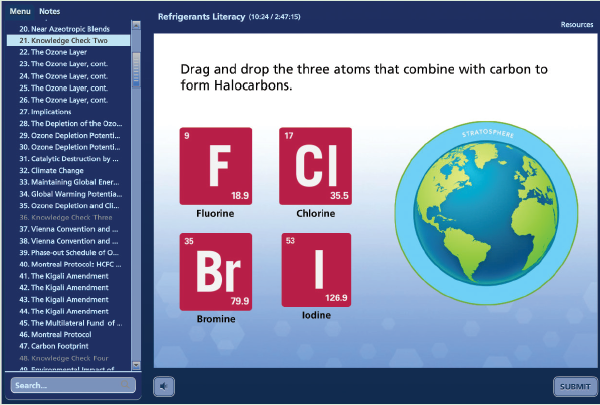
Refrigerants Literacy (SI), 4.5 hours

| UNEP Clients Enrollment |
|
ASHRAE Members Enrollment |
|
|
|
|
|
|
|
|
This 4.5-hour web-based, interactive learning experience is designed to provide NOUs, other developing country policy makers, community stakeholders, and those new to the HVAC&R industry with a basic understanding of refrigerants types, policies, classifications and management practices.
Why Was the Refrigerants Literacy Course Developed?
Refrigerants are the lifeblood of a cooling system. During the past 40 years they have also been at the center of environmental regulations related to protection of the ozone layer and climate change. Anyone involved in the cooling industry or who interacts with the cooling industry must have a basic understanding of the chemistry, the application and the regulation of refrigerants.
Refrigerant Literacy reviews refrigerant classifications, applications, and covers the refrigerant use and management issues that are the bread and butter of daily National Ozone Unit work, including monitoring import/export of refrigerants/applications, setting national policies for the use of refrigerants and placing into market, controlling emissions of ozone depleting substances (ODSs) and their alternatives, updating/advising other authorities and private sector about technology, and designing/implementing national refrigerant management plans.

Who Should Take the Course?
- National Ozone Officers whose work promotes refrigerant transitions.
- Other government officials and policy makers, including UNEP networks, who interact with cooling applications.
- Those new to the HVAC&R industry.
- Students in HVAC&R and Building Sustainability curricula.
- Building owners and other users of RAC systems who influence purchasing and operations yet do not have a basic understanding of the technologies that are available to promote sustainability.
How Is the Course Structured?
Refrigerants Literacy provides 4.5 hours of instruction presenting the basics of how refrigerants are used in air-conditioning and refrigeration applications.
The course consists of 4 lessons:

- Lesson 1 covers refrigerants types and addresses environmental considerations.
- Lesson 2 deals with refrigerant classifications, including ASHRAE Standards 15 and 34.
- Lesson 3 addresses refrigeration selection, including residential and small commercial applications.
- Lesson 4 covers refrigerant management, including the development of a management plan, containers, storage, and recovery, recycling, and reclamation.
This completely web-based, interactive learning experience allows users to track progress and learn in stages when time is available.
Learning checks throughout the course include interactive exercises that test learners’ mastery of the content and prepare. Course navigation is flexible to allow the learner to complete activities in no particular order. Also, learners can skip sections they already know.

Total time to complete the course is estimated at 4.5 hours.
What Are the Learning Objectives?
- Know refrigerant types including pure refrigerants and blends
- Understand the designation system that differentiates refrigerants including safety classifications.
- Understand the environmental considerations and international agreements and standards that apply to refrigerant use, including Ozone Depletion, Climate Change and Energy Efficiency.
- Identify the alternative refrigerants that have replaced the refrigerants with high ozone depletion potential and/or high global warming potential.
- Learn how oils and lubricants interact with refrigerants.
- Know how to safely store and transport refrigerants.
- Know which refrigerants are commonly used for different applications.
- Know what elements are included in comprehensive refrigerant management plans.
Is a Certificate Available?
A final exam of rotating questions is included. The ASHRAE eLearning platform tracks learner progress and delivers a successful completion certificate to those who score 70% or better on a 35-question final exam. The exam draws questions from a data bank, allowing learners to attempt the exam an unlimited number of times. The certificate is delivered from the online platform.
Successful completion also earns 4.5 Professional Development Hours that may be eligible for maintaining certifications or other professional qualification credentials.
Supported Languages / Units
English and Spanish editions available. The course is in SI units.
Enrollment by Others
Courses on similar topics can be found under the Refrigerants subject in the ASHRAE eLearning Catalog.
Contacts for More Information